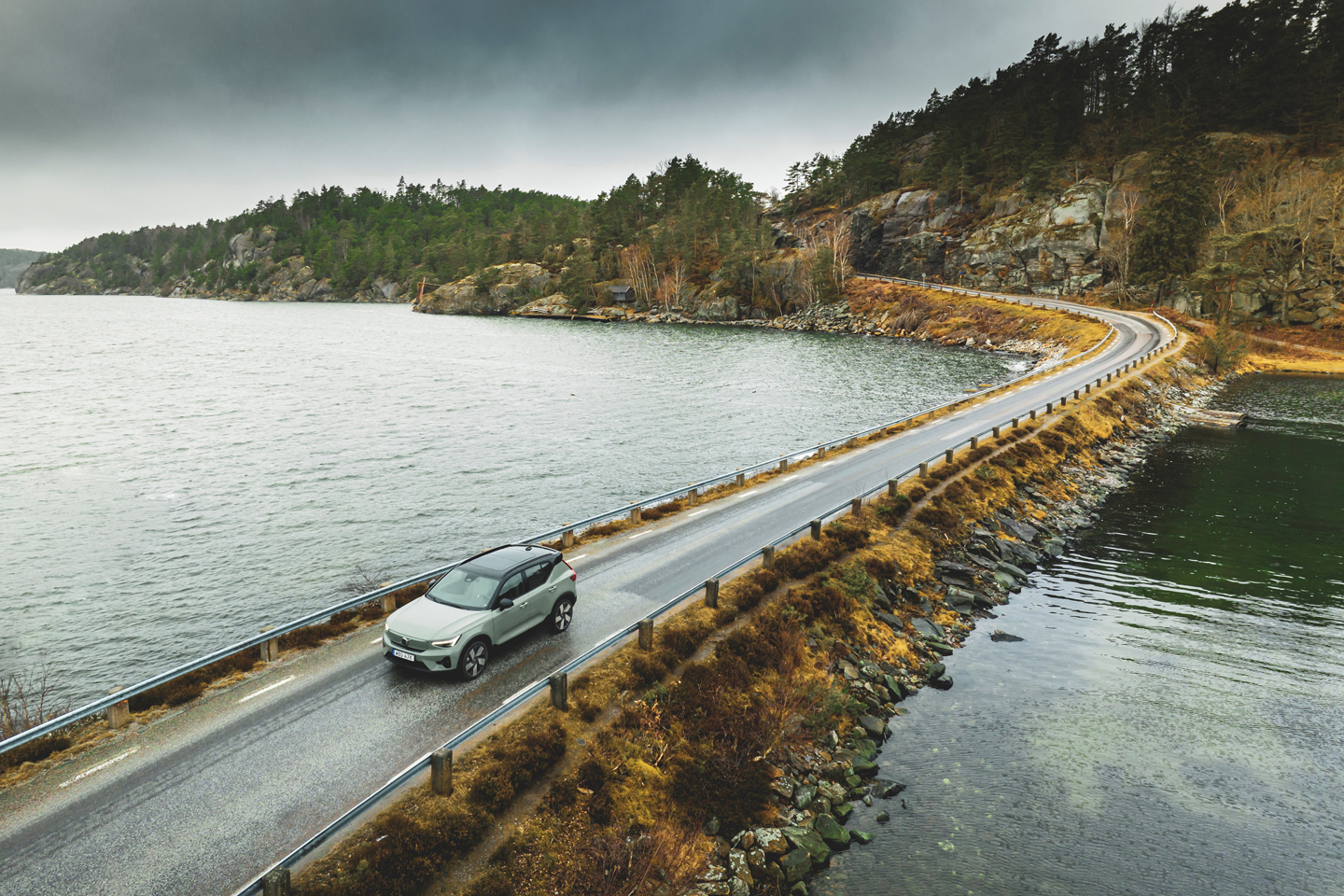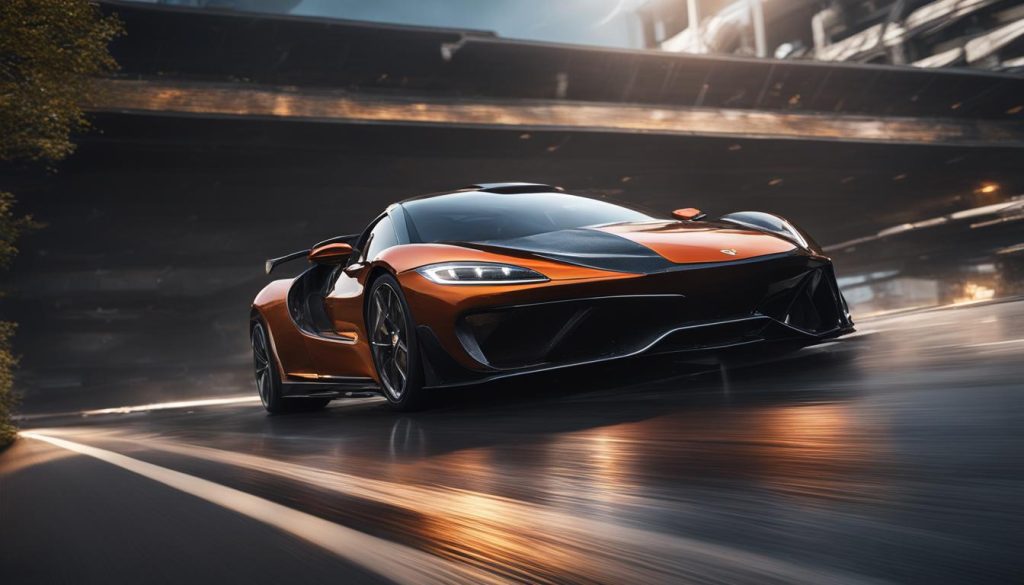
I am not going to say that Volvos are the Ronseal of the car world because that would be ridiculous. There’s nothing ‘written on the tin’, after all. But perhaps there is something similar in the ethos. Because you tend to know what you’re getting with a Volvo. It’s not going to be the sportiest car. It’s not going to be the flashiest, either. It’s going to be a car that’s easy to drive, comfortable and safe. Volvos aren’t the obvious enthusiast choice then – but, as a general rule, there’s a fondness for them which I imagine is directly linked to their genuineness. We do like a Volvo, don’t we?
As with other manufacturers, the company is expanding its range of electric offerings. The EX90 is ready to order now as the all-electric replacement for the XC90 and Volvo’s refining its current crop of BEVs as well. Like the updated XC40 Recharge, which I went to Sweden to drive. On the surface, it doesn’t appear that there’s a whole lot to write about. It looks broadly the same as the old XC40 Recharge, inside and out, and while the single motor variant has seven horsepower more (now 238hp), the dual motor version remains pegged at 408hp. There’s the usual increase in range, but we expect that. It’s all part of the seemingly relentless progression of battery-electric tech – so that’s not really news, either.
However, don’t be fooled. There have been more root and branch changes beneath the XC40’s clean-cut surfaces, and the same updates appear on the C40 coupé as well. As before, the top model is an all-wheel-drive car with motors front and back. The major difference here is that it now uses Volvo’s own in-house-developed, permanent-magnet motor to excite the rear axle. The two-wheel-drive Single Motor version also uses the new motor, but whereas previously it was driving the front-wheel drive, the latest version drives from the rear. That makes the XC40 the first rear-wheel-drive Volvo in a quarter of a century, although the same configuration made it to the Polestar 2 first.
The reason is very simple: there’s a limit to how much torque you can usefully put through the front wheels, and electric cars tend to have a lot of torque. By moving the drive to the rear wheels, Volvo has been able to increase the output of the two-wheel-drive car. As I said, it’s now 238hp with 310lb ft of twist in the UK, but in other markets there’s a 252hp model with the same torque. This is still relevant to us, mind, because the word on the street is the more powerful option will be added to the UK lineup at some point in the not-too-distant future.


The decision to produce its own motor is obvious enough when you think about it. As with developing your own range of combustion engines, it means Volvo can set the brief and develop its hardware to best achieve it. When you’re selecting an off-the-shelf option, you force more limitations upon yourself. That said, the motor in the front of the Twin Motor model remains a bought-in component because, well, one step at a time. It’s still an all-new motor, though. The previous all-wheel-drive XC40 used a permanent magnet motor in the front, but the new one is asynchronous. That means it can be disconnected during normal driving, saving energy, and only switched on to add up to 150hp and 184lb ft when needed. It also has the bonus of being 18kg lighter than the motor it replaces.
Then there’s the battery side of things. There are two sizes, as there were before, and thanks to increased cell density the larger of the two in the Twin Motor has an increased usable capacity of 79kWh. It’s the same battery that goes in the 252hp Single Motor, but our 238hp edition comes with a smaller, 66kWh battery. Those with an eye for detail might notice that’s 1kWh smaller than before. Why? Well, basically the battery is from a different supplier, that’s all; its overall capacity of 69kWh is the same as it always was. The good news is the 238hp Single Motor still has an improved range of 290 miles – that’s up 26 miles. It’s been achieved through a multitude of updates, right down to more efficient wiring, but the bulk of the gains come from Volvo’s motor, which is more efficient, along with better battery cooling. There is a negative, though. It charges more slowly. The peak rate is 130kW instead of 150kW, which means a 10 to 80 per cent charge takes 34 minutes.
The 252hp Single Motor and the Twin Motor’s battery has grown to 79kWh, although physically it’s the same size. That’s because the cells are more densely packed, and along with the same improvements to battery cooling and motor efficiency the range benefits are even greater. The Twin Motor does 334 miles (up 64 miles) and that’s comparatively very good indeed. For example, the Kia EV6 AWD does 314 miles on a single charge and the Tesla Model Y Long Range AWD does 331 miles. The Twin Motor charges at up to 200kW DC, too, so despite its increased capacity it’ll charge from 10 to 80 per cent in 28 minutes.
Because the change from front- to rear-wheel drive for the Single Motor is a major one, Erik Joelsson, whose official title is Product Owner Road NVH and Vehicle Dynamics, has been a busy man. To maximise the traction advantage of this new drive layout he’s developed the rear suspension around a new aluminium rear subframe. There’s more negative camber on the rear wheels, a softer rear anti-roll bar, and reduced spring rates – all to help the rear tyres bite harder under acceleration.


The spring rates have also been reduced, although that’s as much to do with ride comfort as it is grip or traction. Softer springs meant Joelsson could dial out more high-frequency secondary ride disturbance but maintain the body control and compliant primary ride by altering settings of the frequency adaptive dampers – these are passive dampers that vary their damping rates depending on the load they’re under. The reduced weight over the nose required other tweaks, including a new EPAS tune and a different ESP programme. The Twin Motor car has similar upgrades as well.
How does the new car drive after all this spanner work? Well, quite similar to the previous versions in many ways. That’s not a failure, either. If the idea was to maintain the qualities of the old car – easy to drive quickly and comfortable – but transfer them to the new driveline layout of the Single Motor, I’d call this a success. The Tesla Model Y seems to have gone down the ‘make it firm’ route to reduce lean and it has tyres that generate headline grip, but for that you inevitably pay a price: namely, ride comfort, or lack of it. The XC40 isn’t the least bit harsh.
Admittedly, the Swedish roads aren’t as battered as our own because, funnily enough, its government spends sensible money on maintaining them. But I did my darndest to find some holes, and, after around six hours of driving, I found…one. A deepish sunken drain cover. So I lined up the near-side wheel with it, maintained a steady 30mph and…there was no crash or overt harshness. A bit of a jolt, maybe, and that was that. Test complete. In other respects, the ride is well-controlled vertically, and generally compliant although there is some side-to-side sway. That’s always been an XC40 trait, but it’s gentle sway, so it’s not really irritating. And bear in mind our test cars were fitted with all-season tyres that, I was told, would make the ride slightly worse than the summer tyres UK cars will be fitted with. That bodes well, then. I was also told they are quieter than summer tyres but there’s still a noticeable amount of road noise in the XC40. That bodes less well. Wind noise is nicely subdued, though.
I was also told the choice of tyres would affect the steering – the extra movement in the tread blocks making it feel less direct off-centre. I’d noticed that before I was told about it, although this was more of a problem in the lighter steering mode. In the firmer mode, the XC40 is less prone to wandering off line, but the offset is it feels unnaturally heavy as you wind on more lock. Still, I liked the way it steers overall. It’s not a rack that is brimming with feedback – it has very little of that, as it goes – but this is a family SUV. It needs to be predictable, and in that respect, I had no issues with it. When you turn the steering wheel you get the rate of response you expect, and the XC40 turns in faithfully.


The handling delivers more of the same. Yes, there’s more body lean when you start to corner quickly than you might expect from a Model Y or a Kia EV6. But with the front going where you point it and decent damping down undulating lanes, the XC40 feels composed and reassuring. I drove both the rear-wheel drive Single Motor (the non-UK-spec 252hp version with the bigger battery) and the Twin Motor, and, in general driving, they feel very similar. I say general driving because that’s the only style of driving I tried. The roads on our route were sorely lacking the twists and turns required to really engage the chassis and the Swedish speed limits are restrictive. They’re also littered with discrete speed cameras, so if you’re reading this hoping to learn about the intricacies of the XC40’s rear-wheel-drive platform or the differences between two- or four-wheel drive, I am sorry to disappoint you. We’ll have to wait for a UK drive for that.
What I can tell you is that the 252hp Single Motor car feels fast enough. 0-62mph takes a brisk 7.3 seconds and that’s twinned with a very linear power delivery and the usual surfeit of easy-to-access torque from the off. Traction is good on dry roads, although you can feel the ESP tempering things if you give it plenty out of a junction. No surprises there, because it still has just two wheels to divvy its output through, even though it’s a heck of a lot more manageable than its front-wheel-drive predecessor. I can’t imagine many people will actually need the more powerful 408hp car, but if you want it anyway, just for kicks and giggles, then it’s quick. Really quick. 0-62mph in that takes 4.8 seconds, which is fairly blistering for a small, Volvo-badged SUV. It also matches the Long Range Model Y, although the Performance version is quicker still. And with all four wheels sharing the strain there’s no trepidation in using all the performance, either – other than the ever-present threat of those cameras and a large fine. Press the accelerator hard down and the Twin Motor just digs in and fires you towards your destination with a predictably exhilarating sense of urgency.
The rest of the XC40’s package is familiar. That said, I was a little disappointed to see areas of cost-cutting creeping in, with the lower door trims finished in hard plastic when where once they were textured softly (I am sure I am not misremembering that). The dashboard inlays on the test cars were also as cheap as chips. Now, this is very unlike Volvo and I do hope it’s not a sign of things to come because the firm’s interiors are among the best in the business right now. That’s something I would once have written about Audi’s, but since Ingolstadt’s been hacking away at its budgets that’s arguably no longer the case. Volvo would do well to learn from the experience of its rivals – people are buying your cars for many reasons, one of which is that you finish them so well. ‘If it ain’t broke…’ is a cliché for a reason.
But in the main, the XC40 remains a very nice place to be. Most of the surfaces are still plush and little details, like the smoothly damped action of the heater vents, continue to set the XC40 apart from many of its rivals. The seats, too, are smartly trimmed, with the part-Alcantara upholstery in the top-spec Ultimate trim nice, but the optional wool trim is just fabulous. Plus, in typical Volvo fashion, the shape and cushioning of the seats are so brilliant that they’re like muscle relaxants on a long journey. Side support in corners, mind, isn’t great.


This continues to be a very practical compact SUV as well. For its relatively small footprint, it manages to provide more than enough space inside for four tall adults. Legroom is good, but headroom – even with a panoramic sunroof fitted – is exceptional. I am talking about the full SUV version, mind – if you go for the more expensive C40 coupé then the rear headroom is tight and the view out the rear window is not far off Lamborghini bad. The C40 also has a smaller boot at 413 litres, which is useful but a lot smaller than most rivals. Meanwhile, the XC40 has 452 litres of space. That’s better but still smaller than most – the Q4 e-tron, for example, has 520 litres, the ID.4 has 543 litres, and the Model Y’s boot is on a different scale altogether. At least Volvo has made sure there’s plenty of space for the cables to live under the boot floor though, which not every manufacturer remembers to do.
When all is said and done, regardless of boot size, I’d very probably choose the XC40 over all the above. Mainly because it just feels like a regular car rather than some sort of attempt at delivering the future in a way that doesn’t really work in the present. This is a BEV, sure, but it goes about things in a way that’s familiar, which I like very much. Most importantly, it works as a family car. It’s easy to use, comfortable, roomy, fast (or very fast), has a genuinely good range and, despite the downgrades, it’s still better finished than most other EVs. That makes it feel premium, which also makes it feel like a reward and not just a device. In other words, it’s still a Volvo. Figuratively speaking, it’s still doing exactly what it says on the tin.
Specification | Volvo XC40 Recharge Twin Motor
Engine: Asynchronous electric motor (front); permanent magnet motor (rear)
Transmission: Single-speed auto, all-wheel drive
Power (hp): 408
Torque (lb ft): 494lb ft
Battery size: 79kWh (usable)
0-62mph: 4.8 seconds
Top speed: 112mph
Weight: 2,170kg (running order)
Energy consumption: 3.5m/kWh (WLTP)
Electric Range: 334 miles (WLTP)
Price from: £51,755
#Volvo #XC40 #Recharge #Review













